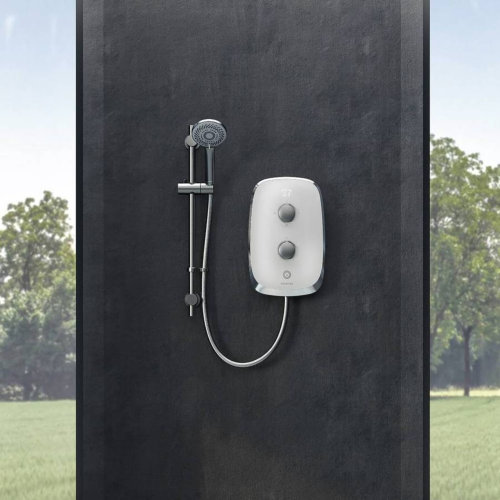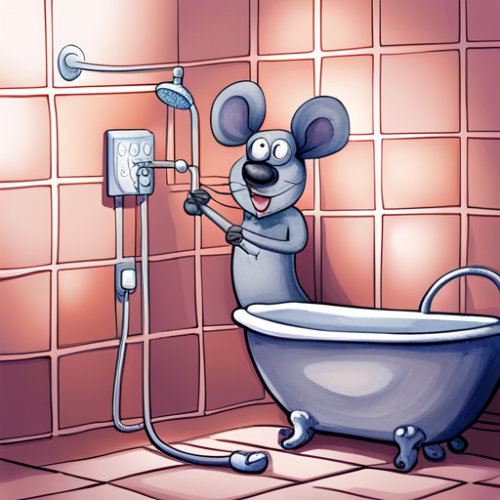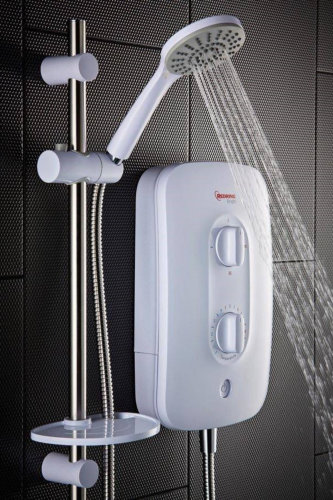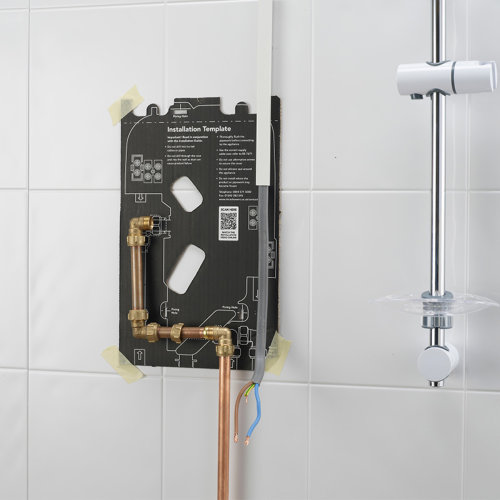| Tags | topical blogs how to guides buyer's guides product news buyer's guide buyers guides buyers guide topical guides show all posts |
How to install an Electric Shower

Are you looking for a way to enjoy hot water on demand in your home? Installing an electric shower is the answer! Electric showers are both affordable and easy to install, making them the perfect choice for anyone wanting hot water with the push of a button. In this blog post, we'll walk you through step-by-step instructions on installing or replacing an electric shower and discuss some of the benefits that come with it. We'll also explain different kw showers available so that you can make sure to pick one best suited for your needs—no matter what those demands may be! So if you're curious about all things related to installing and running an electric shower, keep reading as we dive into everything you need to know!

How to install an Electric Shower
A dream come true - installing an electric shower. If you are reading this blog post, you've likely heard of the convenience and ease of having hot water on demand at the flick of a switch! It is no wonder why many homeowners are opting to replace their existing showers with electric ones (or add one if they haven't got one already).
Installing or replacing electric showers might sound daunting for a novice installer. Still, with a few simple steps (detailed later in this post), you can soon enjoy luxurious hot water on tap without breaking a sweat!
Whether it is understanding what kW power to choose or how best to install your new electrical appliance – these questions we will explore these throughout this blog post. So read ahead and let us help make installation as easy as pie so you can reap the benefits of enjoying hot water whenever you want it safely and cost-effectively!
Benefits of Installing an Electric Shower - Why You Should Make the Switch?
Tired of waiting for your shower to heat up? Say goodbye to chilly mornings and hello to the benefits of an electric shower! Whether you're upgrading your bathroom or simply looking for a way to save on energy bills, there are plenty of reasons to make the switch. With instant hot water and adjustable temperature settings, you'll never have to choose between a cold shower or a scorching one again.
Plus, electric showers use less water than traditional showers, which means you're doing your bit for the environment too. So what are you waiting for? Upgrade to an electric shower and start enjoying the benefits.
Running costs of an Electric Shower
The overall running costs of your electric shower will primarily depend on its wattage, electricity tariff, and usage patterns. Electric shower wattage can vary depending on your chosen model, ranging between 7.5kW and 10.8kW. Higher-wattage electric showers offer improved flow, faster water heating, and pressure but will be more costly.
For example, a 7.5kW electric shower may have an annual operating cost of approximately £155, while a 10.8kW model (typically the highest wattage available) could cost around £223 per year.
In addition to the factors mentioned above, the duration and frequency of showers will also impact the running costs of your electric shower. The longer and more frequent the showers, the higher the energy consumption and associated costs.
It's also important to consider energy-efficient practices, such as taking shorter showers or using a lower power setting when possible. These minor adjustments can contribute to reducing the overall running costs of your electric shower.
Furthermore, using your electric shower during off-peak hours can result in lower energy costs if you're on a variable electricity tariff. Check your specific electricity plan for details on peak and off-peak rates.
Lastly, investing in an energy-efficient electric shower model with eco settings, thermostatic controls, and automatic shut-off can help minimise energy consumption and reduce running costs over time. By making informed choices and adopting energy-saving habits, you can enjoy the benefits of an electric shower while controlling expenses. (see our guide on how to save water and money with Westside Bathroom's Top Tips)
Different Types of Electric Showers - Choosing the Right Kw for Your Home
If you're looking to upgrade your bathroom with an electric shower, you may be surprised at how many options are available. One of the most important factors to consider is your shower's kilowatt (kw) rating. This rating determines how much power your shower uses to heat the water, affecting how quickly it can provide hot water and how much water it can deliver.
Choosing the right kw rating for your household's needs is essential. Too low, and you may not get enough hot water for your shower, while too high, and you might face astronomical energy bills. Understanding the different types of electric showers, how they work, and their kw ratings will ensure you make an informed decision about which one is right for your home.
Westside Bathrooms has over 50 Electric Showers for you to choose from, ranging from 7.5Kw to 10.8Kw. Some of our most popular products and the most cost-effective on the market are our Redring Electric Showers, including the Redring Pure 8.5Kw Electric Shower available at less than £65, and the more higher-class Redring Bright 8.5Kw Multi Connection Electric Shower at a little over £100. For further finishes, and brands, we also offer a huge selection of Bristan Showers including some of our popular showers such as the Bristan Glee 9.5Kw Black Shower.
Step-by-Step Guide to Installing an Electric Shower
Installing an electric shower can seem daunting, but with the proper knowledge and tools, you'll be singing in the rain in no time! If you're replacing an existing electric shower, self-installation is possible since the power and water connections are already in place. In this case, the process of installing a new shower unit and riser rail can be relatively straightforward. But if you're starting from scratch, consider hiring a plumber or electrician with 'Part P' certification to ensure safe and secure installation.
Just be aware, for those who are not qualified electricians, attempting to wire an electric shower could lead to serious injury, damage to the bathroom, and a costly bill if professional repairs are needed.
Following our eight steps, the step-by-step guide makes the process easier and safer, keeping safety tips in mind throughout the installation. With proper maintenance and troubleshooting, these appliances can bring you years of convenience and comfort.
Before you begin, check the kW rating of the new shower unit. If it has a higher wattage than the previous one, you may need an electrician to change cables to handle higher currents. It's always best to consult a professional if you need clarification.
Step One: Gather the Necessary Materials - Before starting, ensure you have everything you need to install your electric shower successfully. This includes a circuit tester, cable, screws and mounting brackets.
Step Two: Disconnect the power supply to the existing shower unit. Before removing it, verify that the electrical supply is functioning correctly. After confirming that the shower is turned off, switch off the water supply as well.
Note: Basic knowledge of electrics is required for this step, and we would always recommend a professionally qualified electrician.
Step Three: Inspect your new shower unit for the water supply connection, ideally in the same location as the old one. Some models, like the Aqualisa eMotion Electric Showers, have multiple connection options for easy replacement and features such as retrofit for easy installation. Adjustments may be needed if connections differ. A popular choice is the Aqualisa eMotion 9.5Kw White Electric Shower – available from Westside Bathrooms alongside the Space Grey version of this 9.5Kw eMotion.
Remove the front panel of the new unit by unscrewing four screws (two at the top and two at the bottom). This will reveal the electrical connections and water connections inside. If the new unit doesn't fit in the same spot as the old one, you may need professional plumbing or electrical help.
Step Four: Mark the position of the new unit on the bathroom wall, covering any holes from the previous device. Also, mark the spots where new screw holes are needed. Attach Support Brackets - Attach the support brackets to the wall for secure installation of your new electric shower. Make sure that they are firmly fixed in place before proceeding to step 4.
Step Five: Carefully drill the holes into the wall, avoiding damage to surrounding tiles. Use a masonry bit instead of a "hammer" setting to prevent tile breakage. Once the holes are drilled, insert rawl plugs and screw in your new shower unit.
Step Six: Feed Cable Through Unit - This is an important step so take your time! Carefully feed the cable through the unit, making sure there are no kinks or sharp bends in it before attaching it to the wiring. It’s also recommended that you hire a qualified electrician to undertake this task as incorrect wiring could result in serious injury or even death due to electrocution.
Step Seven: Double-check that everything inside the unit is correctly positioned, including neutral, live, and earth wires, as well as pipes. Consult a professional if unsure about completing this step correctly. Once everything is connected correctly, use a circuit tester to double-check that all connections are safe before turning on the power supply again.
Step Eight: After confirming the wiring is in the right place, reattach the front panel of the electric shower unit and turn on the power and water supply. Now your electric shower should be ready for use! Enjoy hot water on demand at any time without waiting for it to heat up slowly, like with traditional showers!

Is it possible for anyone to install an electric shower?
Although technically, anyone could attempt to install an electric shower, it doesn't necessarily mean they should.
The professional installation of an electric shower contributes significantly to the overall cost of acquiring a new shower. Even a simple installation, where the cold-water supply is readily available and the path from the shower to the main electrical supply (shower unit) is uncomplicated, can cost more than the shower itself.
While a plumber or electrician can handle the plumbing aspect, hiring a Part P-certified electrician is essential to wire, test, and certify the electrical components.
Installation costs can vary if you prefer to hire a plumber or electrician. Expect to pay between £190 and £300 for a like-for-like replacement. If you do not already have an electric shower, then a survey would need to be completed on your electrics, which could result in identifying the need to replace the consumer unit. Therefore, the costs of installing an electric shower where one is not present could range from £600 to £1,500.
Why shop at Westside Bathrooms?
Westside Bathrooms has been trading for nearly 40 years and provides a full range of bathroom products, including showers, enclosures, sanitaryware, furniture and Brassware. Westside Bathrooms can help supply you with the best products on the market, whatever your needs, budget, style or inspiration.
We have a team of customer service staff who can help you with your order, give advice and answer any questions. Call 01472 266100 or contact via e-mail at info@westsidebathrooms.co.uk for any help at any stage of your buying journey.



